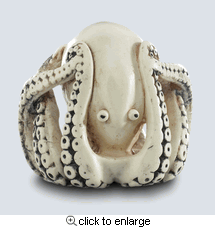Difference between revisions of "Netsuke"
| Line 1: | Line 1: | ||
Netsuke literally means "root for fastening" (ne tsuke). Netsuke are toggles worn by Japanese men of the upper and middle classes. These "roots for fastening" developed from a practical object to a coveted collector's item. | Netsuke literally means "root for fastening" (ne tsuke). Netsuke are toggles worn by Japanese men of the upper and middle classes. These "roots for fastening" developed from a practical object to a coveted collector's item. | ||
| − | + | [[Image:Mfa 2031 435139035.gif|Octopus netsuke]] | |
===The Origins=== | ===The Origins=== | ||
Revision as of 19:03, 1 January 2009
Netsuke literally means "root for fastening" (ne tsuke). Netsuke are toggles worn by Japanese men of the upper and middle classes. These "roots for fastening" developed from a practical object to a coveted collector's item.

Contents
The Origins
The origin of netsuke is of a rather practical manner. Japanese kimonos had no pockets. The kimono was tied together with a sash or belt, called obi. So everything that you would carry in a pocket was put into a pouch or a box and attached to the sash with strings. The netsuke with two openings for the string to pass, acted as a toggle to prevent the sagemono (everything hanging from the sash) from slipping down from the obi. The channel or hole carved into the netsuke for the passage of the cord is called the himotoshi. If a netsuke has a natural opening for the cord to pass, one speaks of a natural himotoshi.
Far beyond their practical use, they were considered as a status symbol by their owners. Soon netsuke developed from a simple practical object to an impressive piece of art of high standard. In Japan strict rules of dress forbade ostentatious displays of wealth. Netsuke were not subject to these laws because they were not technically clothing; nor were they subject to restrictions placed on art, where representations of religious matter were forbidden. As a result, no subject or material was off limits to netsuke artisans: Flowers, animals, and characters from No or Kabuki theater, religion, or mythology were carved from ivory, bone, wood, clay, lacquer, and precious metals. While many netsuke remained plain and purely functional, wealthier Japanese displayed netsuke that were wearable art. Thus, social status could be revealed through netsuke in ways it could not through dress.
Netsuke were in use from at least the early 17th century to the second half of the 19th century. With the Meiji restoration, the Japanese adopted Western clothing, which made netsuke disappear as an item for daily use by Japanese men. After their heyday during the 18th and 19th centuries, the importance of netsuke waned. By the end of the 1800s Japan was becoming Westernized; suits with pockets replaced the long-worn kimono, and rolled cigarettes did away with the need for pipes and loose tobacco. For a form of sculpture usually no more than three inches tall, netsuke played a sizable role in Japanese culture: functional, social, and aesthetic.
Types of Netsuke
Netsuke can be categorized into different types.
- katabori - the normal compact form of a netsuke
- sashi - a long and thin netsuke
- kagamibuta - a netsuke in the form of a bowl with a lid on top
- manju - a round and flat netsuke that resembles a button
The Materials
Netsuke come in a wide variety of different materials. The dominant materials are ivory and wood. Wood is not restricted to a specific tree but comes in a great number of wooden materials - many unknown outside of Japan. Other than ivory and wood, many other materials were used like bone, horn, shell, amber, soapstone or ceramic.
Collectors of netsuke should be familiar with possible import/export and buying restrictions due to legislation for the protection of endangered species. They are different from country to country. Buying and selling antique items with material like ivory within the member states of the European Union is legal and does not require any permits. Exports outside the EU member states require a special permission.
The Subjects
As subjects for a netsuke, the 12 animals of the Asian zodiac were rather popular. But also mythological, heroic and scenes from everyday's life were chosen. Some netsuke show humorous scenes.
The Carvers
Netsuke carvers are called Netsukeshi. The netsuke carvers came from rather different artistic backgrounds. Some were painters or sculptors, others had a more craftsmanship background as mask or puppet makers.
Most netsuke were not signed. Except for paintings or prints, it was not common to sign works of art. Some carvers did. The existence of a signature does not have much influence on the value of a netsuke.
The Soken Kisho, a book from the eighteenth century contains a list of netsuke carvers.
Contemporary Netsuke
When netsuke were no longer used as a utilitarian by Japanese men, they nevertheless were continued to be produced - for export to the west. These pieces were carved by skilled designers and are by no means of any minor quality.
The development that the netsuke took was comparable to what happened to ukiyo-e printmaking at the beginning of the twentieth century. Ukiyo-e as a print medium for the masses had been replaced by photography. Nevertheless ukiyo-e saw a new renaissance with the shin hanga movement. But these prints were created mainly for export.
Today there are about fifty to hundred professional artists worldwide (Japanese and non-Japanese) who continue to produce netsuke of high standard. A netsuke created by a well known contemporary netsuke artist sells for a four digit dollar price.